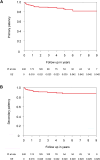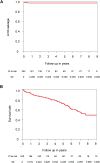Long-Term Results of Crossover Bypass for Iliac Atherosclerotic Lesions in the Era of Endovascular Treatment: The Re-ACTION Study (Re trospective A ssessment of C rossover Bypass as a T reatment for I liac Lesi ON s)
- PMID: 30116414
- PMCID: PMC6094041
- DOI: 10.3400/avd.oa.18-00007
Long-Term Results of Crossover Bypass for Iliac Atherosclerotic Lesions in the Era of Endovascular Treatment: The Re-ACTION Study (Re trospective A ssessment of C rossover Bypass as a T reatment for I liac Lesi ON s)
Abstract
Objective: The aim of this study was to elucidate the long-term results of crossover bypass (CB) for iliac atherosclerotic lesions in the era of endovascular treatment (EVT). Methods: A retrospective multicenter cohort study was performed. CB was performed in 242 patients between 2003 and 2014 by vascular surgeons at multiple medical centers in Japan. Results: Perioperative mortality was 1.7%. Primary patency rates were 86% at 5 years and 82% at 8 years. Univariate analysis showed that critical limb ischemia (Rutherford class 4-6), vein graft, and superficial femoral artery occlusion were significantly associated with low primary patency. In multivariate analysis, only critical limb ischemia influenced primary patency. The secondary patency rate was 87% at both 5 and 8 years. The limb salvage rate was 98% at both 5 and 8 years. The overall survival rates were 71% at 5 years and 49% at 8 years. Conclusion: The long-term results of CB were good in our study, compared with previous reports. Our results suggest that CB remains an option for the arterial reconstruction in unilateral iliac occlusive disease after EVT failed.
Keywords: crossover bypass; long-term results; peripheral arterial disease; unilateral iliac occlusive disease.
Figures
References
-
- Norgren L, Hiatt WR, Dormandy JA, et al. Inter-society consensus for the management of peripheral arterial disease. Eur J Vasc Endovasc Surg 2007; 33 Suppl 1: S1-75. - PubMed
-
- Ichihashi S, Higashiura W, Itoh H, et al. Long-term outcomes for systematic primary stent placement in complex iliac artery occlusive disease classified according to Trans-Atlantic Inter-Society Consensus (TASC)-II. J Vasc Surg 2011; 53: 992-9. - PubMed
-
- Ye W, Liu CW, Ricco JB, et al. Early and late outcomes of percutaneous treatment of TransAtlantic Inter-Society Consensus class C and D aortoiliac lesions. J Vasc Surg 2011; 53: 1728-37. - PubMed
-
- Rutherford RB, Baker JD, Ernst C, et al. Recommended standards for reports dealing with lower extremity ischemia: revised version. J Vasc Surg 1997; 26: 517-38. - PubMed
-
- Mingoli A, Sapienza P, Feldhaus RJ, et al. Femorofemoral bypass grafts: factors influencing long-term patency rate and outcome. Surgery 2001; 129: 451-8. - PubMed
LinkOut - more resources
Full Text Sources
Other Literature Sources


